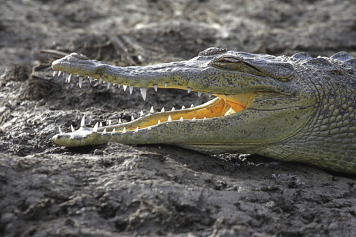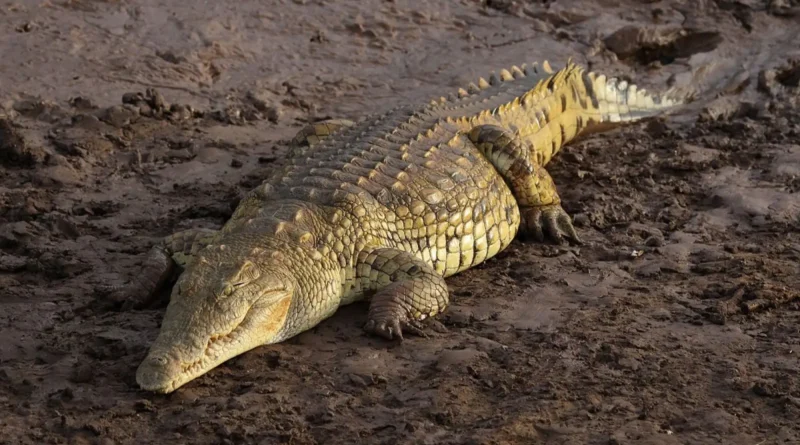Nile Crocodile Population Decline
Nile Crocodile Population Decline The Nile crocodile (Crocodylus niloticus) is one of Africa’s most iconic and formidable predators. As an apex predator, it plays a crucial role in maintaining the balance of ecosystems across the continent. However, in recent years, its population has been in decline, posing a serious threat to both the species and the habitats it inhabits. This article delves into the causes, impacts, and potential solutions for the troubling decline of the Nile crocodile population.
Historical Population Overview

Once widespread across sub-Saharan Africa, the Nile crocodile historically thrived in a variety of freshwater habitats, including rivers, lakes, and wetlands. They were especially abundant in the Nile River, Lake Victoria, and the Okavango Delta. Their resilience and adaptability have allowed them to survive for millions of years, evolving to become one of the most successful reptilian species on Earth. However, human activities and environmental changes over the last few decades have drastically altered the landscape, leading to a steep decline in their numbers.
Here’s a table summarizing key factors related to the Nile crocodile population decline and conservation efforts:
| Category | Details |
|---|---|
| Species Name | Nile Crocodile (Crocodylus niloticus) |
| Current Conservation Status | Least Concern (IUCN), but with regional population declines |
| Primary Habitats | Freshwater rivers, lakes, wetlands (e.g., Nile River, Lake Victoria, Okavango Delta) |
| Main Causes of Decline | – Habitat destruction (urbanization, dam construction) |
| – Human-crocodile conflict (retaliatory killings) | |
| – Poaching and illegal trade (for skin and body parts) | |
| – Climate change (temperature rise, water scarcity) | |
| Role in Ecosystem | Apex predator: Regulates prey populations, maintains balance in aquatic ecosystems |
| Conservation Efforts | – Protected areas and national parks (e.g., Uganda, Botswana) |
| – Community-based conservation programs | |
| – Captive breeding and reintroduction initiatives | |
| Challenges in Conservation | – Lack of funding and resources |
| – Weak enforcement of anti-poaching laws | |
| – Negative public perception of crocodiles | |
| Success Stories | – Stabilized populations in some regions due to conservation programs |
| – International regulations (CITES) curbing illegal trade | |
| Future Projections | Mixed: Dependent on continued conservation efforts, habitat protection, and human cooperation |
| Potential Solutions | – Expansion of ecotourism to incentivize local communities |
| – Increased public education on the ecological importance of Nile crocodiles |
This table summarizes the key issues and conservation strategies associated with the Nile crocodile’s population decline.
Causes of Population Decline
- Habitat Destruction
Urban development, agricultural expansion, and the construction of dams have significantly disrupted the natural habitats of Nile crocodiles. Wetlands and river systems, which serve as vital breeding grounds, have been drained or polluted. Dams alter water flow, reduce prey availability, and limit access to key nesting sites. These changes fragment populations and reduce the number of suitable environments for crocodiles to thrive. - Human-Crocodile Conflict
As human populations expand and settle near crocodile habitats, encounters between humans and Nile crocodiles have become more frequent. In some regions, crocodile attacks on livestock or even people prompt retaliatory killings. This conflict has led to significant population losses in areas where crocodiles are perceived as threats to communities. Fear and misunderstandings about the species exacerbate the problem. - Poaching and Illegal Trade
Nile crocodiles have long been hunted for their valuable skins, which are used in the fashion industry to produce leather goods. While regulated hunting exists, illegal poaching continues to threaten crocodile populations. The demand for crocodile skin, as well as for their body parts in traditional medicine, remains high in certain regions, contributing to population declines. - Climate Change
Rising global temperatures and changing rainfall patterns are affecting Nile crocodile habitats. Warmer temperatures can disrupt the species’ nesting cycles, as sex determination in crocodiles is temperature-dependent. Additionally, water scarcity and reduced prey availability due to droughts are further straining crocodile populations, particularly in regions already prone to environmental stress.
Conservation Status

The Nile crocodile is currently listed as “Least Concern” by the International Union for Conservation of Nature (IUCN). However, this classification masks regional variations in population health. In some countries, such as Egypt, South Africa, and parts of East Africa, significant declines have been recorded due to the factors mentioned above. On the other hand, some areas have seen stabilization or even recovery thanks to conservation initiatives. But the overall trend points to a population under increasing pressure, and without stronger intervention, more declines are likely.
Impact of Population Decline on Ecosystems
As apex predators, Nile crocodiles play a critical role in regulating prey populations, such as fish and small mammals. By doing so, they help maintain the balance of aquatic ecosystems. A decline in their population can lead to an overabundance of certain species, which can disrupt the food chain and degrade the health of wetlands and rivers. Furthermore, the absence of crocodiles could lead to a decline in species diversity and the overall productivity of freshwater ecosystems.
Conservation Efforts and Success Stories

Despite the challenges, there are success stories in Nile crocodile conservation. Some countries have established protected areas that safeguard crocodile habitats from human encroachment and poaching. For example, national parks in Uganda and Botswana have provided crucial sanctuaries for crocodile populations.
Community-based conservation programs have also shown promise, with local communities being educated on the importance of crocodile conservation and given incentives to protect the species. In regions where crocodile populations are recovering, reintroduction programs and captive breeding efforts have also been employed to boost numbers.
International organizations, such as the Convention on International Trade in Endangered Species (CITES), have helped curb the illegal trade in crocodile skins by regulating the sale of products derived from the species.
Challenges in Conservation
While there have been successes, many obstacles remain. Funding and resources for conservation programs are often insufficient, making it difficult to maintain long-term efforts. Additionally, enforcement of anti-poaching laws and wildlife protection policies is weak in certain regions, allowing illegal hunting to persist.
One of the biggest challenges is public perception. Many people living near crocodile habitats view them as dangerous pests rather than vital parts of the ecosystem. Changing this mindset through education and awareness campaigns is essential for fostering coexistence between humans and crocodiles.
The Future of Nile Crocodiles

The future of Nile crocodiles is uncertain. While some populations are stabilizing, many others continue to decline. Projections for the next decade are mixed—without increased efforts to protect their habitats, mitigate human-wildlife conflict, and curb illegal hunting, we may see further declines in their numbers.
Ecotourism has the potential to play a vital role in their conservation. By turning crocodile habitats into tourist destinations, communities can benefit economically from the presence of crocodiles, which may encourage them to protect the species rather than view them as a threat.
Conclusion
The decline of the Nile crocodile population is a pressing issue that requires urgent attention. Habitat destruction, human conflict, illegal poaching, and climate change are the primary culprits behind this alarming trend. Conservation efforts, while promising in some regions, need to be scaled up and supported by stronger enforcement and public education.
As apex predators, Nile crocodiles are essential to the health of freshwater ecosystems. Protecting them is not only crucial for maintaining biodiversity but also for ensuring the stability of the environments they inhabit. The path forward will require cooperation between governments, conservationists, and local communities, but with concerted effort, there is hope for the Nile crocodile’s future.
Tips for Helping Protect Nile Crocodiles
Support Conservation Organizations
Donate to or volunteer with organizations focused on protecting Nile crocodiles and their habitats. Groups working on wildlife conservation need funding and support to carry out their mission.
Promote Ecotourism
Choose responsible travel companies that prioritize wildlife conservation and habitat protection when visiting areas with crocodile populations. Ecotourism provides economic incentives for local communities to protect crocodiles.
Spread Awareness
Educate others about the importance of Nile crocodiles in maintaining ecosystem balance. Share information on social media or in your community to raise awareness of their declining populations.
Reduce Your Ecological Footprint
Support sustainable water and land use practices that help preserve freshwater ecosystems where Nile crocodiles live. Avoid products linked to habitat destruction or illegal wildlife trade.
Advocate for Stronger Laws
Urge your government or international bodies to enforce stronger anti-poaching laws and protect natural habitats. Effective law enforcement is crucial for preventing illegal crocodile hunting and trade.
Avoid Buying Crocodile Products
Do not purchase products made from Nile crocodile skin or body parts unless they come from a certified, sustainable source. Illegal wildlife trade fuels poaching and contributes to population declines.
Support Community-Based Conservation
Engage with and support projects that work with local communities to reduce human-crocodile conflict and promote coexistence. These initiatives can help minimize retaliatory killings and foster positive relationships.
FAQs on Nile Crocodile Population Decline
Why are Nile crocodiles important to the ecosystem?
Nile crocodiles play a crucial role as apex predators in freshwater ecosystems. They help regulate populations of fish, amphibians, and other prey species, ensuring ecological balance. Their presence contributes to the health of aquatic habitats by preventing overpopulation and maintaining biodiversity.
What are the main causes of the decline in Nile crocodile populations?
The primary causes include:
- Habitat destruction due to urban development, dam construction, and agricultural expansion.
- Human-crocodile conflict, often leading to retaliatory killings.
- Poaching and illegal trade for their skins and body parts.
- Climate change, affecting water availability and breeding cycles.
How does human-crocodile conflict contribute to their decline?
As human settlements expand into crocodile habitats, the chances of conflict increase. Crocodiles may attack livestock or, in rare cases, humans, leading to retaliatory killings. This conflict is a significant factor in the decline of Nile crocodile populations near human settlements.
Are Nile crocodiles endangered?
Currently, Nile crocodiles are listed as “Least Concern” by the IUCN due to their wide distribution across Africa. However, in many regions, their populations are in decline, and without intervention, they could face more serious threats in the future.
What is being done to protect Nile crocodiles?
Several conservation efforts are underway, including:
- Establishing protected areas to safeguard habitats.
- Community-based conservation programs that promote coexistence between humans and crocodiles.
- International laws like CITES to regulate the trade of crocodile skins and parts.
- Reintroduction and captive breeding programs in regions where populations are dwindling.
How does climate change affect Nile crocodiles?
Climate change impacts crocodiles by altering temperatures, which influence the sex of hatchlings. Warmer temperatures can also lead to reduced water levels in their habitats, affecting their prey availability and breeding success.
Can Nile crocodiles coexist with humans?
Yes, Nile crocodiles can coexist with humans through effective management and education. By creating awareness about their importance and promoting conservation strategies like ecotourism, communities can benefit economically while reducing conflict.
How can individuals help in conserving Nile crocodiles?
Individuals can help by:
- Supporting wildlife conservation organizations.
- Avoiding products made from illegally sourced crocodile skins.
- Spreading awareness about the threats to crocodile populations.
- Promoting ecotourism and sustainable travel to areas where crocodiles live.
What role does ecotourism play in Nile crocodile conservation?
Ecotourism provides economic benefits to local communities, giving them an incentive to protect crocodiles and their habitats. It also raises awareness among visitors about the importance of preserving these reptiles and their ecosystems.
Is poaching still a major threat to Nile crocodiles?
Yes, despite some regulations, illegal poaching remains a significant threat, particularly for the crocodile skin trade. Stronger enforcement of anti-poaching laws and sustainable sourcing of crocodile products are needed to curb this threathttps://crocogen.blog/.
